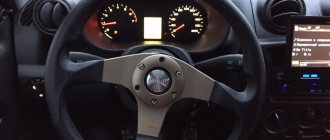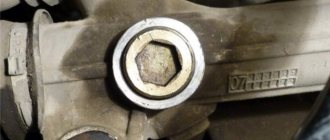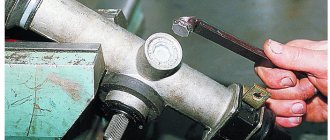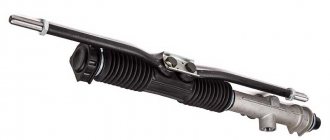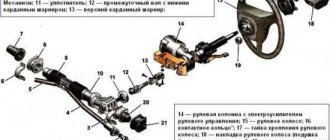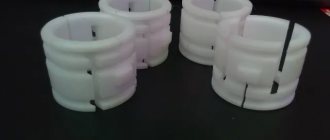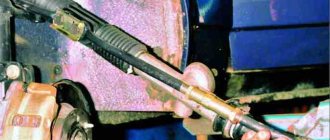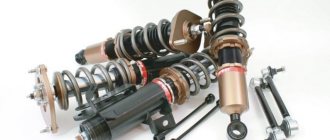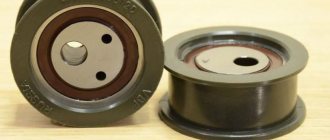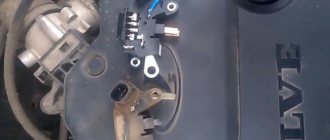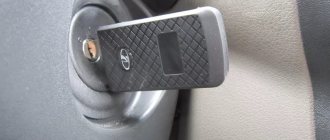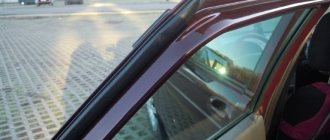The steering rack began to knock. How to tighten it up?
- ESD on VAZ Priora turns off - 2 answers
- Should the steering wheel turn over bumps? – 1 answer
- On a Priora, the steering rack check light is on - 1 answer
- Why does the steering wheel shake when braking - 1 answer
This is possible. Remove the battery and its stand, which is secured with 13 bolts. You don’t have to remove it completely, but move it away so that your hand can freely crawl under the rail.
Then use your hand to feel the rack adjustment mechanism and pull out the rubber plug. It is used when you need to lubricate the mechanism. Next, we put our hand under the left rail, put a special wrench into the hole and slightly tighten the nut inside.
There is no need to tighten it too much, just turn it 20-30 degrees clockwise. If you overtighten, the steering wheel may bite during sharp turns. By the way, you can also tighten the steering rack on Kalina.
Subscribe
to our channel in
Index.Zen
Even more useful tips in a convenient format
When does the steering rack need to be tightened on a Priora?
The first sign indicating the need to adjust the rack is the appearance of a knocking sound when driving over small uneven surfaces. The knocking will be felt especially clearly when driving on country roads. In this case, the driver will feel shocks and vibrations on the steering wheel, which will also be transmitted to the entire car body.
In addition, if the steering wheel adjustment nut is loosened when driving on the highway, the car will “float” a little, and additional steering will be required from the driver, which will also immediately become noticeable.
Experts also say that a tightening is necessary if the driver begins to notice the appearance of a clearly audible crunching sound in the area of the steering column, as well as an increase in the amplitude of the steering wheel rotation.
Features of operation with power steering
The Priors were equipped with electric and hydraulic power steering. But the presence of such units does not affect the repair procedure, so you can safely follow the algorithm described above.
But there is one small nuance - on cars with a hydraulic booster installed, when replacing the rack, you will have to completely drain the fluid from the reservoir. And if a steering rack is installed on a Priora with an electric power steering system, you will need to disconnect the battery. But if you refer to the above procedure, you can see that the battery is completely removed at the first stage of repair.
When tightening doesn’t help and the mechanism needs to be changed
It’s worth thinking about replacing the rack when tightening it does not in any way affect the car’s behavior on the road, and also does not help get rid of the unpleasant knocking noise. A failed steering rack will cause significant play in the steering wheel. Moreover, it may begin to jam (this happens extremely rarely, but similar cases are known). If the rack begins to jam, then it is better to stop using the car, as this can lead to the most dire consequences.
You cannot do without a replacement even if after tightening it you managed to get rid of knocks and vibrations, but they reappeared later.
The nuances of working on a car with EUR and power steering
According to experienced auto mechanics, the process of tightening the steering rack on cars with electric steering and power steering is practically no different, so this guide can be called universal.
This is interesting: The complexity of the work performed during the maintenance and repair of the Grant sedan
It is worth noting that the complete replacement process is also identical in the case of electric steering and power steering, with the exception of one point - in cars with power steering, before replacing the rack, it is necessary to drain the fluid from the power steering tank, and in cars with electric steering, remove the terminals from the battery.
What is needed for work and how to tighten the steering
To perform the tightening you will need the following tools:
- Slotted screwdriver (in simple terms, a “flat” screwdriver);
- Wrench 13;
- A special 17mm wrench designed to adjust the steering rack.
To make the work more comfortable and faster, it is recommended to drive the car into a special inspection hole or overpass, and also use an assistant, whose role even a child can handle.
To get to the rail, you should perform a number of simple steps:
- Disconnect the battery terminals and dismantle it;
- Using a 13mm wrench, unscrew the bolt securing the battery stand, and then remove it;
- Directly under the steering rack, using a slotted screwdriver, you need to pull out the small plug of the adjustment system.
After this, you will have access to the nut responsible for adjusting the thermal gap in the rail.
Next, you need to put your hand under the steering rack and try to put the rack wrench on the nut. It is necessary to tighten the nut clockwise, but since the rack itself is located upside down, from the outside it may seem that the nut must be tightened counterclockwise. Experts recommend tightening the nut no more than 25–30 degrees at a time, after which you should try to rotate the steering wheel, which should turn without jerking or biting.
It is also necessary to listen to the sounds coming from the steering wheel - if there are no knocks when turning the steering wheel, and there are no other noises, then the rack is tightened correctly, and you can put the battery and rubber plug in their place.
The tightening process on video
Major failures of the EUR
Experienced drivers and Prior owners can observe the following trend - breakdowns occur in the same parts, weak points of the system. Why is this happening?
The first thing you need to pay attention to is the operation of the electric power steering. After the system has been completely turned off, a code should appear on the on-board computer - it reports the cause of the breakdown. Each code has its own interpretation. However, very often the real reason for the cessation of operation of the amplifier can be determined only after a full diagnosis has been carried out. In order to find out about the nature of the breakdown of the Lada Priora electric power steering, do the following:
- The engine is turned off and the steering wheel is turned a couple of times.
- The engine turns on and the steering wheel turns several times.
The absence of changes in the applied efforts is a sure indicator that the power steering is disabled.
It is quite possible to drive with the system turned off, but it is not recommended. It is very difficult to understand the features of control with and without an electric booster. Therefore, it is better to perform a diagnosis. It will help determine which component has failed, whether it can be repaired or whether it is better to replace it with a new one.
Sometimes you can observe the following situation: the speedometer and the sensor stop functioning at the same time. This most often occurs due to a malfunction of the speed sensor. The sensor provides data to the control unit, which processes the information on the speedometer and determines the supply of the required amount of force.
If the cause of the breakdown is the sensor, the solution to the problem is simple. It is enough to check the quality of the wires and, if necessary, replace them with new ones. If the wires are in good condition, it is recommended to replace the sensor itself.
Stopping the operation of the electric power steering can also occur due to insufficient voltage. This occurs due to violations of the wire insulation - short circuits can occur. For the same reason, the generator stops working. The sensor has a huge number of wires, which over time can become dusty or clogged. In this case, you need to disassemble it and carry out “general cleaning”.
Fuse removal process
If, during smooth and smooth movement forward, the car turns sharply to the side, it is recommended to carry out unscheduled diagnostics. After all, such unpredictable behavior of the Priora’s electric power steering will not happen without emergency situations. Park and unplug the unit: Disconnect the fuse to stop power supply to the amplifier.
To remove the fuse, you need to do the following:
- we find the cover of the mounting block, localization is near the driver’s left foot;
- rotate the clamps;
- disengage the clutch;
- we find the block in which the fuse is located;
- we extract it.
A car malfunction indicates problems with the ESD. There can be many reasons for this, the breakdown of one part or several. To determine the cause as accurately as possible, seek specialized diagnostics. And you can replace or repair a damaged part yourself.
The process of removing the electric amplifier
If you decide to replace the electric power steering on a Prior car or make sure that its individual parts are in working condition, you need to remove the unit completely. For this you will need:
- chisel;
- head for 8 or 13;
- extension;
- ratchet.
The process of removing the EUR is simple and fast. The process is lengthy: you need to remove the steering wheel, grab the airbag, then remove the cover and finally, the ignition switch. After all this, you can take out the electric amplifier.
How to tighten the steering rack
Before we begin describing this repair, if it can be called such at all, let's look at the main reason why you have to tighten the steering rack on a Priora.
So, I think that many owners know that when a knock appears from the steering rack or its rod, it is necessary to make an adjustment, or rather, tighten the rack using a special nut, which is located on the inside of the case, which is clearly visible in the photo below.
To understand where this nut is located, look at the photo below, everything is shown from above - from the hood side, of course, in this case this nut is located on the reverse side:
To get to this adjusting nut, you will most likely have to remove the battery, since without it there is more free space under the hood. Although the good news is that even the battery in the Priora does not interfere with this repair (unlike cars such as Kalina or Granta).
It is worth noting that you may need the following tools for work:
- 10mm wrench or socket wrench
- key for 13
- the key for tightening the rack is exactly 2110 and not 2108
Now, using a special key from the inside, as shown in the photo below, insert it into the hole:
It is enough to make less than half a turn, and then try the play on the rods. If it disappears and there is no more knocking, then there is no point in tightening it further, since you can overdo it, and in this case the rail may bite. For a more visual example and description of the entire procedure, watch the video report below.
Tips for use
A complete replacement and repair is a series of actions, for the implementation of which you need to have not only special knowledge, but also a considerable amount of free time, so if the car owner does not have either the first or the second, it is preferable to go to the nearest service station.
It is better to entrust steering rack repair to service station specialists
At the same time, in order not to become their regular guest, you should know some secrets for operating the steering rack, which can significantly extend its service life.
- We strongly do not recommend “jumping” your car on curbs, or driving at high speed on rails, since each such trip causes cracks to appear on the rack itself, as well as deformation of the shaft that is part of the steering mechanism.
- It is not recommended to frequently turn the steering wheel all the way. Of course, in this case it will be very difficult to demonstrate your maneuvering capabilities, but this will significantly increase the life of one of the most important parts of the machine.
- Carefully monitor the condition of the protective anthers, which must maintain their tightness. Replacing anthers is several times cheaper than replacing the entire rack.
- It is also worth monitoring the level and condition of the hydraulic fluid, since its decrease or change in color is associated with problems in the vehicle’s hydraulic system, which can result in rack failure.
From time to time you need to undergo a full maintenance, which will allow you to eliminate faults in advance, which can cause irreversible consequences, injury to yourself, your loved ones and other road users. And also, if problems are detected in the operation of the car, it is better not to take risks and go to the nearest car service center as quickly as possible.
About the rake
The steering mechanism on Lada cars, starting with model 2108, has a steering rack. It is designed to move steering rods along a horizontal plane, which helps turn the car's wheels.
The design of the slats is quite simple and reliable, with the exception of one small drawback - a plastic bushing.
This bushing is made by the manufacturer from low-quality plastic, which soon leads to play in the rasp in it and the appearance of an unpleasant knock when moving on paving stones.
There is a rail between the engine and the passenger compartment, perpendicular to the exhaust manifold and attached with two brackets to the engine shield.
Tools for repairs
In order to independently repair the Priora steering rack, you will need certain tools and equipment. In particular, the following tools are needed:
- Slotted screwdrivers (flat).
- Spanners, open-end wrenches, heads 13.
- Special wrench 17 for adjusting the steering rack.
In order to complete all the work as quickly as possible, you need to install the machine on an inspection hole, lift or overpass. Help won't hurt you either, so you should have a partner. He will not be required to know the components and assemblies of the car, so you can use the help of your child or wife.
Design
Steering rack design: 1 – shaft boot, 2 – cover mounting bolts, 3 – Belleville washer, 4 – worm shaft oil seal, 5 – worm gear cover, 6 – sealing collar, 7 – thrust bearing, 8 – worm shaft with bearing, 9 – rasp, 10 – left boot, 11 – binoculars, 12 – binocular bracket, 13 – nut plug, 14 – thrust nut, 15 – thrust spring, 16 – locking collar, 17 – thrust piston collar, 18 – thrust rasp piston, 19 – piston liner, 20 – steering rod bolt, 21 – stopper, 22 – plate, 23 – plastic clamp, 24 – steering rack boot, 25 – left side boot, 26 – steering rack pipe.
Signs of play in slats
When driving over small irregularities such as a gravel road, shocks and knocks in the suspension are clearly audible and are transmitted to the steering wheel. These signs will not always refer to play in the rack. Similar impacts to the steering wheel can occur due to broken steering ends or a broken crosspiece of the steering mechanism. Before you begin repairing the rack, you must exclude the tips and steering cross from suspicion.
- Impacts to the steering wheel when driving over bumps
- Creaking sound when turning the steering wheel
- Biting the steering wheel in different positions
- The steering wheel does not return to zero position
Checking for play
Checking for play is done by rocking the swing arms up and down. To do this, we find the steering rods under the hood and pull each of them up and down; there should be no play or knocking. If any, then the rack should be maintained.
Gur
The entire set of rack with power steering for Lada Priora contains:
- Oil tank;
- High and low pressure hoses;
- Steering mechanism with built-in power steering of the rack-and-pinion type;
- Vane type oil pump.
The power steering operation process is similar to the movement of a piston in a hydraulic cylinder: when the pump pumps out working fluid, it pushes the pistons, reducing the required driver effort to turn the wheels. At the same time, it is not for nothing that the power steering is praised for the fact that it leaves the driver the opportunity to feel the road, because with a torsion-type switchgear it acts on the pistons with exactly the same pressure that prevents the steering wheel from turning freely, and nothing more. Based on this, the greatest pressure in the system generally occurs when the car is stationary - that is, when the driver makes the greatest effort to turn the wheels.
When driving at speed (for example, in case of changing lanes), the steering movement is not so significant (can reach 0.2 turns), and there is no pressure on the system. That is why even in driving schools, students are taught to perform maneuvers so that the steering wheel turns when starting to move, and not when the car’s wheels are still held in place by the working brake system.
You will have to tinker with it: the pump drive belt must be fully tensioned, otherwise its complete breakage can cost a pretty penny. It is also important to monitor the condition of the hydraulic fluid: top it up to about 0, do not turn the steering wheel in a cold car with thick oil, contact a service center twice a year for professional diagnostics.
There is also one “trouble” that, it would seem, is not related to the operation of the power steering: you should not jump on curbs, otherwise you can hit it and damage the control mechanisms. In return, the disadvantages of power steering will give the Priora owner increased directional stability even when one of the front wheels goes down, smoother driving over uneven surfaces and the relief of not having to try to forcefully twist the steering wheel for a normal maneuver.
Lift
If knocking is detected in the steering wheel, it can be tightened, but tightening will be effective only if there is knocking from the worm gear. If the knocking noise comes from a broken plastic bushing, then tightening is useless.
As is known from practice, the worm mechanism is quite reliable and is very rarely the culprit of knocking. Most often the bushing is to blame.
You can determine the culprit of the knock by pulling the steering rods one by one.
- If there is a knocking sound when applying forces to the right link, then the bushing is to blame.
- If there is a knocking sound when you apply force to the left linkage, then the worm gear is to blame.
In the first case, a lift is not advisable. Since the tightening nut only tightens the worm mechanism. To eliminate the knocking noise, it is necessary to remove the steering rack from the car and have it repaired.
Replacing bushings
It happens that tightening the central nut of the steering wheel does not help. The steering wheel continues to “beat”. In this case, the triangular bushings on the steering wheel rod should be replaced. To do this you need:
- Inspection hole, set of keys;
- Remove the steering wheel by unscrewing the four fastening bolts and remove the mechanism from the engine compartment;
- Clamp in a vice and place subsequent parts on a clean, dry surface. This could be a newspaper or a rag;
- Remove the boot, unscrew the two bolts that hold the steering rack “worm”, pull it out;
- Pull out the rail itself with the bushings;
- After removing the old ones, install new plastic bushings on the rail. At the same time, carry out a visual diagnosis of the integrity of the mechanism. If the teeth are damaged, urgent replacement is necessary;
- We install new bushings, add lubricant, preferably graphite. Putting the mechanism back together;
- Next we carry out the procedure described above for tightening the steering wheel.
Minor repairs require more than one hour. If the car has not been used for a long time, for example, in winter, then after the first trips, breakdowns in the steering rack are also possible. This is due to plastic bushings, which are very fragile and susceptible to the negative effects of temperature changes.
Remember to purchase spare parts and repair kits only from certified points of sale. The better the quality of the part, the longer its service life. So, how to tighten the steering rack on Priora and Kalina is now clear. On average, the mechanism lasts no more than 30,000-40,000 km. until complete renovation. Good luck to you on the roads.
Repair kit
In a Priora with an EUR, a rack from Kalina was installed with catalog number 11183-3400010 20. Therefore, the repair kit must be purchased specifically from Kalina.
Steering rack number
The repair kit includes a large number of parts necessary for repairs.
The price of a new rack starts from 5,000 rubles and higher, depending on the manufacturer, but new does not mean good, and the cost of a repair kit varies from 500 to 1,000 rubles, which is almost 10 times cheaper than a new rack.
Standard rail: article number and price
Lada Priora is a “converted Lada 2110.” Some parts from the tenth family may be suitable for it, but they are already structurally outdated. In the set for the old Lada 2110 you can find:
- Rake and rasp from VAZ 2108, straight-cut (3.7 turns). Article 2108-3400009-20
- The body is different, the rasp is from 2108, straight-toothed (3.7 turns). Article 2110-3400009-20
In the set for the new Lada 2110:
- Rasp 2110-3401068 with helical gears and variable pitch (4.2 turns). Article 2110-3400012
- Short rack with power steering (2.7 turns). Article 2110-3400010-30
The factory steering rack set for Priora contains:
- Rasp 21100-3401068-00 (4.2 turns). Article 11183-3400010-20;
- Rasp 2110-3401068 (4.2 turns). Article 11183-3400010;
- Short with power steering (2.7 turns). Article 21100-3400010-30;
- The article number for the rack set for Lada Priora with ESD will contain the model number - 2170.
EUR - electric power steering - is called an improved mechanism compared to hydraulic power steering. The fact is that power steering is more demanding on driving style. As an example, power steering does not tolerate moments when the steering wheel is held in the extreme position for several seconds - the working fluid simply overheats. In addition, you have to monitor the oil level in the tank, the pump, and carry out diagnostics twice a year - servicing the mechanism.
With an electric booster everything is a little simpler, but at the price of a rack for a Lada Priora with an electric power steering it will cost almost 2.5 times more - its average cost is 25,000 rubles.
